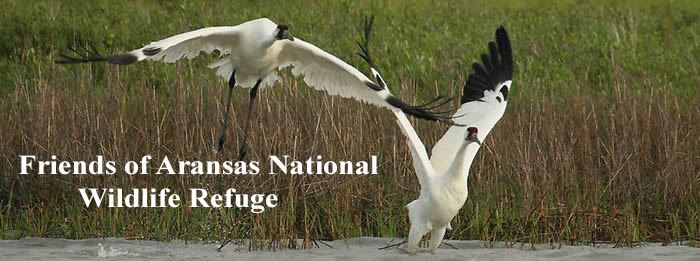Whooping Cranes:
The majority of the radio-marked whooping cranes have migrated to their wintering grounds on the Texas coast. There have also been sightings of cranes in Oklahoma. The survey season has begun and we hope to have preliminary estimates available for the next update. Visitors coming to the refuge have a chance of seeing four adult whooping cranes that have been frequenting the observation tower.
Surveys & Monitoring:
Refuge biologists conducted the first whooping crane aerial survey of the season November 28, 2012, and the second survey is being flown today. Data analysis is ongoing and several additional flights are scheduled to occur prior to December 17th. Based on the first flight, the cranes appear to be evenly distributed from Lamar to south of Port O’Connor and the marsh conditions look good.
Thanks to the Texas Parks and Wildlife Department's
Whooper Watch, the public has reported seeing several whooping cranes at Granger Lake near Austin, Texas, more than 150 miles north of the survey area. Additionally, whooping cranes have been seen in the uplands and utilizing the sand dunes of Matagorda Island, a behavior that is typical of sandhill cranes.
Precipitation/Salinity:
As of November 28th, the monthly precipitation levels for Aransas National Wildlife Refuge are 0.61 inches and salinity levels for San Antonio Bay are recorded as 29.4 parts per thousand. The National Oceanic and Atmospheric Administration is still predicting a wetter than average winter and spring for coastal Texas in 2013. Because El Niño's development was abruptly halted, the agency has revised its prediction of the weather for the remainder of most of the country.
Food Abundance:
Refuge staff continue to find whooping crane scat filled with wolfberry seeds. This year’s wolfberry crop on the refuge has been abundant and is being utilized by the birds.
Refuge Update:
Whooping Crane Coordinator Dr. Wade Harrell will be heading up the aerial surveys this season. Wade is from Corpus Christi and has a B.S. in Wildlife and Rangeland Science from Texas A&M Kingsville. He earned both his M.S. and PhD from Oklahoma State University in Rangeland Ecology. He has served with the U.S. Fish & Wildlife Service as the Partners for Fish and Wildlife Program Coordinator for the Austin Ecological Services office since 2009 where he led a team of biologists in restoring and maintaining diverse wildlife habitats. Prior to coming to work for the Service, Wade was employed by The Nature Conservancy of Texas serving as the Coastal Prairies Project Director for six years.
Sonny Perez is the new deputy refuge manager. Sonny comes most recently from the Laguna Atascosa National Wildlife Refuge in the lower Rio Grande Valley where he managed the 90,000-acre refuge known primarily for its recovery efforts on ocelots, a highly endangered wild cat. In addition, Sonny led the refuge’s efforts on Kemp’s Ridley sea turtle recovery efforts, as well as managed a large public use program, habitat restoration work, oil and gas issues, land acquisition and more. He graduated from Texas A&M Kingsville and is originally from Falfurrias.
Refuge Manager Dan Alonso reached 25 years of service and has decided to retire. His plans are to remain in the area where he will continue to be involved in whooping crane issues. Brad Strobel, refuge biologist, accepted a position closer to his family in Wisconsin. His new position will be with the Necedah National Wildlife Refuge, the refuge that hosts the Eastern migratory flock of whooping cranes each summer for nesting. We wish Dan and Brad the best of luck and thank them for their service to the Aransas National Wildlife Refuge.
